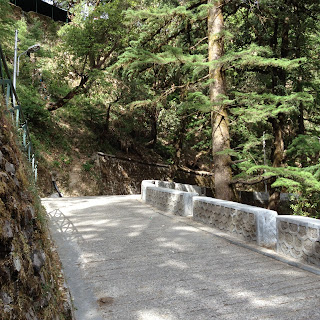It is now been
two weeks since I arrived in Landour to study Hindi. Coming from Delhi, the
first sensation is one of immense relief: set at 2800 meters high amidst
century-old woodlands, Landour offers a precious respite from the pre-monsoon
swelter of the plains. In some nights, one may even feel the need to wear a
sweater.
Landour is not
so much a town or a village as it is a place. In addition to the school, which
is located on the grounds of the Kellogg Church built by American Presbyterians
in 1903, there are two other points of confluence: Chaar Dukan (literally, and
fittingly, ‘Four Shops’) and Sister’s Bazaar. The latter is composed by three
shops, two of which belong to Mr Prakash so that while he, his son and his
son-in-law sit in the grocery, his wife and daughter sell local handicrafts
next door. This should give you an impression of the dimension of the place. I
am staying a little further down the road in a homestay with a room overlooking
the Himalayas (though the dust and the smog from trash burning have prevented
me from actually catching a glimpse).
The Landour Language School
Now, on the
Hindi education. After two weeks, I have nothing but praise to say about the
Landour Language School. The course is very well drafted, the professors are
professional and the school is generally run like a Swiss clock. Classes last 50 minutes (a bang marks their termination) and each class is taught by a
different professor so that each hour students can be seen exchanging rooms
(and professors). There are several professors and students request which ones
they wish to have on the following week (forms must be placed in a box until
12:00 every Wednesday). Although a complete match between student’s wishes and
professors’ schedules is often difficult to obtain, my experience so far has
been quite positive as the school has generally accommodated my wishes. I am
taking four classes each day (individually) and the day’s works are as follows:
first class grammar, second reading, third vocabulary, and fourth speaking and
revision.
Vocabulary and plural drill
In these two
weeks my progress has been quite astonishing. The introductory Hindi manual has
30 chapters, designed for an intensive course lasting three months. Since I already knew some Hindi, in the first week I was able to move quickly until
chapter eight. This covered the entire alphabet, present tenses of several
verbs (to come; to go; to eat; to drink; to give; to take; among others),
personal pronouns as well as basic questions (who are you?; what is your name?;
etc). During the second week, I moved on until chapter thirteen. This included
plurals of masculine and feminine nouns, oblique forms of plural nouns (plural
+ post positions), numbers, date and time, days of the week, infinite, past and
ultra-polite imperative. Thus, in these two weeks I covered almost half of the
introductory course. Although the level of difficulty increases from here onwards,
I am hopeful that I will be able to finish the manual in the following weeks.
Until then, thanks for reading!
Diogo Lemos
PhD student in Political Science
2012 Sigur Center Grant for Asian Language Study in Asia
Hindi in India



No comments:
Post a Comment